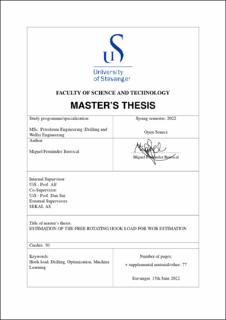| dc.description.abstract | Today’s drilling industry emphasizes safety and deeper drilling while reducing drilling costs. Low rate of penetration (ROP) and non-productive time are two main reasons for reduced drilling efficiency.
Machine Learning (ML) technology has been increasingly used in the Oil and Gas industry for a variety of problems, including drilling parameters estimation and prediction, drilling inci- dents detection, and optimal well planning.
With the abundance of field data available, a number of detailed research studies have been conducted to define the relationship between the ROP and drilling parameters. However, de- veloping a pure data-driven ROP model and optimization remains very challenging. The main reason for this is the number of parameters that affect its estimation, as well as the manner in which different variables are correlated, e.g., the downhole weight on bit (DWOB), rotary speed (RPM), standpipe pressure (SPP), and formation/bit properties [1]. Thus, we suggest breaking down the ROP data-driven problem into its primary parameters and focusing on them separately.
Analyzing time series for hook load when drilling with connections is the purpose of our study. In drilling operations, hook load is used to control the weight on the bit. Due to the in- ability to measure WOB directly during drilling, the tension at the top of the drill string is used to determine WOB. As of now, the industry is letting the driller select manually a free-rotating hookload choice according to his judgment and experience. This task of manual inspection and selection is tedious and, according to experts, often left behind due to the number of tasks at a time the driller has to deal with. This recorded value will be used to calculate the WOB indi- rectly while drilling. With an industry that is more autonomous than ever before, this would not be a viable option, and a different approach is proposed in this research.
In essence, this research is an attempt to estimate automatically and more accurately rather than relying on the experience and judgments of the driller, the free rotating hook load. The approach will be accomplished by developing a hybrid system combining ML algorithms with statistical analysis and physics principles.
As a result of embedding this rig state identification engine idea, we will be able to classify and analyze different real-time data points (e.g., out-of-slips, pick-up, rotating off-bottom, and drilling), obtain the free rotating hook load, and also to utilize it in other applications, such as T&D calibration. | |
